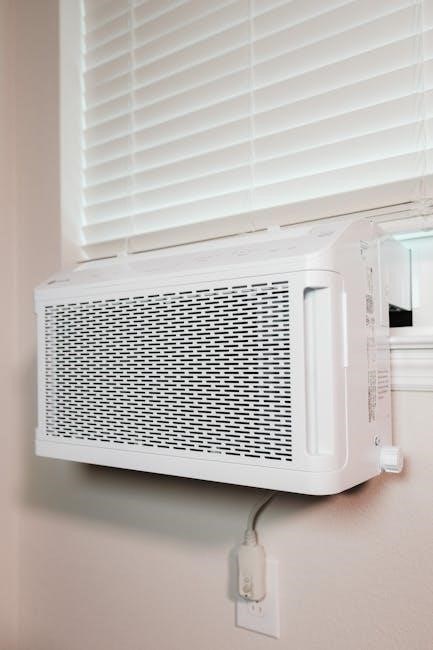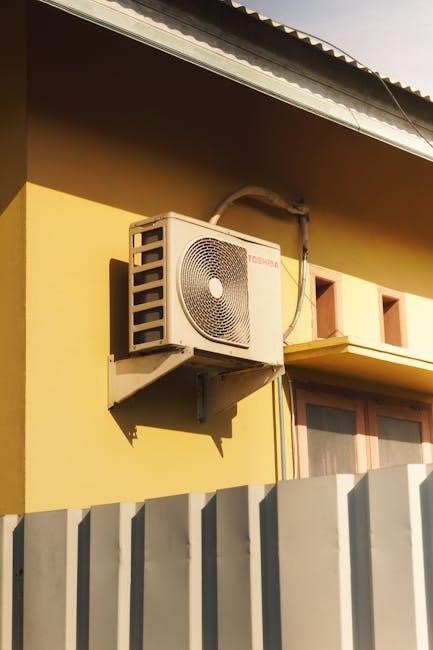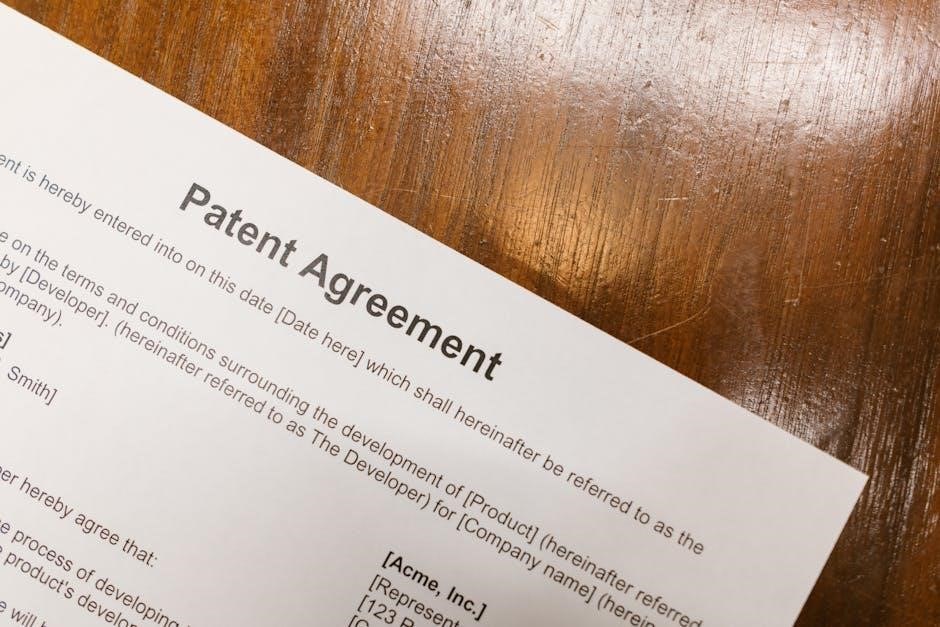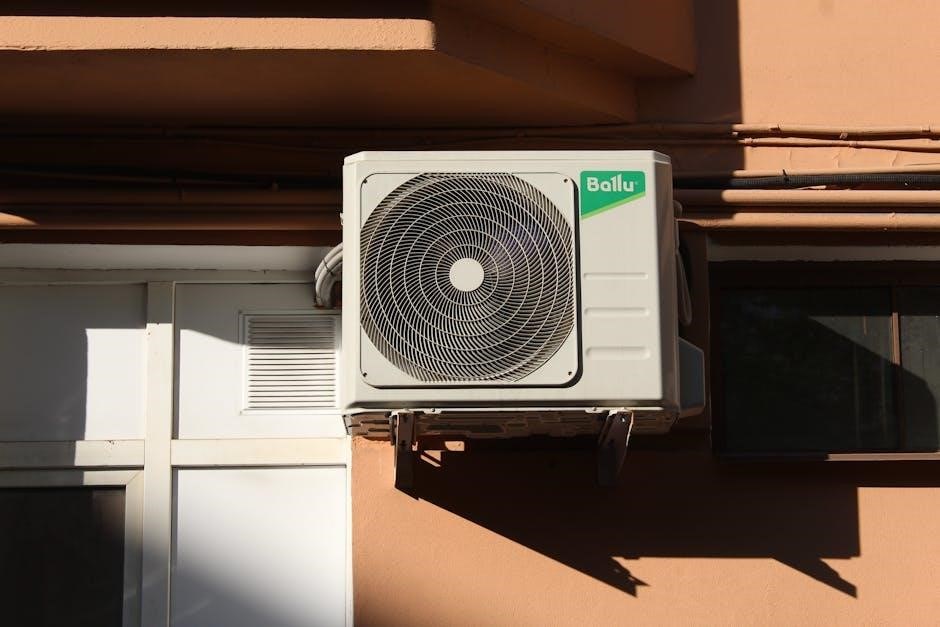HVAC systems provide thermal comfort, air quality, and humidity control in buildings. They integrate heating, cooling, and ventilation to create healthy indoor environments, essential for productivity and well-being.
What is HVAC?
HVAC stands for Heating, Ventilation, and Air Conditioning. It refers to systems designed to regulate indoor environmental comfort by controlling temperature, humidity, and air quality. HVAC systems are essential for maintaining thermal comfort and ensuring healthy indoor air quality in residential, commercial, and industrial spaces. They integrate various components, such as heaters, coolers, and ventilators, to create a balanced and comfortable environment. Understanding HVAC terminology is crucial for optimizing system performance and addressing specific climate control needs.
Importance of HVAC in Building Design
HVAC systems are critical in building design for ensuring thermal comfort, air quality, and energy efficiency. They regulate temperature, humidity, and ventilation, creating a healthy indoor environment that enhances occupant productivity and well-being. Proper HVAC design integrates with architectural elements to optimize space utilization and energy performance. It also supports sustainability goals by reducing energy consumption and operational costs. Effective HVAC systems are essential for meeting modern building standards and occupant expectations, making them a cornerstone of contemporary building design and construction.
HVAC Glossary of Terms
A comprehensive glossary defining key HVAC terminology, explaining components, and clarifying industry-specific language to enhance understanding of heating, ventilation, and air conditioning systems and technologies.
A to E HVAC Terms
Absolute Humidity: The mass of water vapor in a given volume of air. Air Flow: The movement of air through a system, measured in cubic feet per minute (CFM). BTU (British Thermal Unit): A unit of energy used to measure heating and cooling capacity. Coefficient of Performance (COP): The ratio of heat moved to the energy consumed by a heat pump. Damper: A device that regulates airflow in ducts. These terms are fundamental for understanding HVAC systems and their operations.
F to J HVAC Terms
Fan Coil: A device that uses a fan and coil to heat or cool air in a space. Filter: A component that removes airborne particles to improve air quality. Heat Pump: A system that transfers heat from one location to another, providing both heating and cooling. Humidity: The amount of moisture in the air, affecting comfort levels. Insulation: Material used to reduce heat transfer and energy loss. These terms are essential for understanding HVAC components and their functions in maintaining indoor environments.
K to T HVAC Terms
Latent Heat: Heat involved in phase changes (e.g., condensation or evaporation). Mini-Split System: Ductless HVAC system for individual spaces. Refrigerant: Substance used in cooling systems to absorb heat. Sensible Heat: Heat that changes air temperature without phase changes. Thermostat: Device controlling system operation based on temperature settings. Ton of Refrigeration: Unit measuring cooling capacity, equivalent to 12,000 BTUs. These terms are fundamental for understanding HVAC operations and system performance.
U to Z HVAC Terms
Upflow Furnace: A furnace designed to circulate heated air upward through ductwork. Variable Air Volume (VAV): A system adjusting airflow to maintain consistent temperatures. Watt: A unit of electrical power. Expansion Valve: Reduces refrigerant pressure before entering the evaporator coil. Yearly Operating Hours: The annual runtime of an HVAC system. Zoning: Dividing a space into sections for independent heating or cooling control. These terms encompass key concepts in HVAC systems, aiding in their efficient operation and design.
Types of HVAC Equipment
HVAC systems include furnaces, heat pumps, boilers, air conditioners, evaporative coolers, and ventilation equipment like air handlers and energy recovery ventilators (ERVs). These components work together to regulate indoor climates efficiently.
Heating Equipment
Heating equipment in HVAC systems includes furnaces, boilers, heat pumps, and radiant floor systems. Furnaces use combustion or electricity to heat air, while boilers heat water for radiators. Heat pumps transfer heat between indoors and outdoors, offering both heating and cooling. Radiant floor systems circulate warm water through floors for even heat distribution. These technologies vary in efficiency and installation complexity but all aim to provide reliable and efficient indoor heating solutions.
Cooling Equipment
Cooling equipment in HVAC systems includes air conditioners, chillers, and evaporative coolers. Air conditioners circulate refrigerants to remove heat from indoor air, while chillers produce cold water for cooling systems. Evaporative coolers use water evaporation to lower air temperature, ideal for dry climates. These technologies enhance indoor comfort by controlling temperature and humidity, ensuring efficient operation and energy savings in various applications.
Ventilation Equipment
Ventilation equipment ensures proper air circulation and quality by exchanging stale indoor air with fresh outdoor air. Key components include fans, blowers, and ductwork. Heat recovery ventilators (HRVs) and energy recovery ventilators (ERVs) enhance efficiency by transferring heat or energy between incoming and outgoing air. These systems maintain indoor air quality, reduce moisture, and prevent pollutants from accumulating, ensuring a healthy and comfortable environment while optimizing energy use in residential and commercial spaces.

Thermostats and Controls
Thermostats regulate temperature, humidity, and airflow, ensuring optimal comfort. Smart thermostats offer remote control and energy efficiency, while zoning systems allow customized temperature settings for different areas.
Types of Thermostats
Thermostats regulate HVAC systems by maintaining desired temperatures. Common types include programmable, smart, and manual models. Programmable thermostats allow pre-set temperature schedules, while smart thermostats offer remote control and energy-saving features. Manual thermostats are basic, requiring physical adjustments. Each type ensures precise temperature management, enhancing comfort and efficiency. Thermostats are essential for optimizing HVAC performance, tailored to different user preferences and needs.
Smart Thermostats
Smart thermostats are advanced devices that optimize HVAC system performance through intelligent controls. They offer remote accessibility via smartphones, enabling users to adjust settings from anywhere. Features include geofencing, voice control, and energy usage reports. Smart thermostats learn occupancy patterns to automatically adjust temperatures, improving efficiency and comfort. They integrate with smart home systems, providing a seamless experience. Energy savings and convenience make smart thermostats a popular choice for modern HVAC systems.
Zoning Systems
Zoning systems divide a building into separate areas with independent temperature control, enhancing comfort and efficiency. They use dampers and zone controls to direct airflow based on specific needs. This setup allows different zones to maintain unique settings, reducing energy waste. Smart zoning systems integrate with thermostats, optimizing performance. By addressing varied cooling and heating demands, zoning systems improve overall HVAC efficiency and user satisfaction, making them ideal for larger spaces or buildings with diverse occupancy patterns.

Indoor Air Quality
Indoor air quality focuses on maintaining clean, healthy air in buildings by controlling pollutants, humidity, and ventilation. Proper HVAC systems ensure optimal air circulation and purification.
Importance of Air Quality
Maintaining good indoor air quality is crucial for health, comfort, and productivity. Poor air quality can lead to respiratory issues, allergies, and long-term health problems. Key factors include controlling airborne pollutants, managing humidity, and ensuring proper ventilation. HVAC systems play a vital role by filtering, purifying, and circulating air effectively. Clean air promotes better indoor environments, reduces sick building syndrome, and enhances overall well-being. Regular maintenance of HVAC systems ensures optimal performance in improving air quality and creating a healthier space for occupants.
Air Purification Systems
Air purification systems are essential for improving indoor air quality by removing airborne pollutants, allergens, and harmful gases. These systems integrate with HVAC setups to filter and clean the air, ensuring a healthier environment. Common technologies include HEPA filters, activated carbon, and UV light systems. They effectively reduce contaminants like dust, mold, and bacteria, minimizing respiratory issues. Regular maintenance of these systems is crucial for optimal performance. By enhancing air purity, they contribute to better health, reduced odors, and a more comfortable indoor space, making them a vital component of modern HVAC solutions.
Humidity Control
Humidity control in HVAC systems regulates moisture levels in the air to maintain comfort and prevent issues like mold growth. Proper humidity management ensures optimal indoor air quality, reduces energy consumption, and prevents structural damage. Devices like humidifiers, dehumidifiers, and hygrostats are used to balance moisture levels. Managing humidity also enhances thermal comfort, making spaces feel cooler in summer and warmer in winter. Effective humidity control is crucial for preventing condensation, minimizing odors, and safeguarding equipment from corrosion, ensuring a healthier and more efficient indoor environment year-round.
Duct Cleaning and Maintenance
Duct cleaning and maintenance are crucial for ensuring HVAC system efficiency and indoor air quality; Over time, ducts accumulate dust, mold, and allergens, which can circulate airborne contaminants. Regular cleaning reduces the risk of respiratory issues and maintains optimal airflow. Maintenance involves inspecting ducts for leaks or damage, sealing gaps, and replacing filters. Proper upkeep prevents energy losses, enhances system performance, and extends equipment lifespan. Clean ducts also reduce odors and ensure a healthier indoor environment, making maintenance a vital part of HVAC system care.

Energy Efficiency in HVAC
Energy efficiency in HVAC systems is crucial for reducing operational costs and environmental impact. Key terms like SEER, AFUE, and HSPF define system efficiency, helping users make informed decisions.
Energy Efficiency Ratings
Energy efficiency ratings are critical for evaluating HVAC system performance. These ratings, such as SEER, AFUE, and HSPF, measure how efficiently systems convert energy into heating or cooling. Higher ratings indicate better efficiency, leading to lower energy bills and reduced environmental impact. Understanding these ratings helps consumers and professionals select systems that meet their needs while optimizing energy use. Regular maintenance and proper system sizing further enhance efficiency, ensuring HVAC systems operate at their peak performance levels and provide long-term cost savings. These ratings are essential for making informed decisions in HVAC system selection and operation.
SEER, AFUE, and HSPF Explained
SEER (Seasonal Energy Efficiency Ratio) measures cooling efficiency, AFUE (Annual Fuel Utilization Efficiency) assesses heating efficiency, and HSPF (Heating Seasonal Performance Factor) evaluates heat pump performance. SEER is calculated by dividing cooling output by energy consumption, while AFUE measures the percentage of fuel converted to usable heat. HSPF assesses heat pump efficiency over a heating season. Higher ratings indicate better efficiency. These metrics help consumers compare HVAC systems and make informed decisions to balance performance and energy costs. Understanding these ratings ensures optimal system selection for specific climates and energy needs.
Green Building Standards
Green building standards aim to reduce environmental impact by promoting energy efficiency and sustainability; LEED and ENERGY STAR are key certifications that guide HVAC system design. These standards emphasize efficient equipment, renewable energy integration, and smart controls. They also focus on indoor air quality through proper ventilation and filtration. By adhering to these standards, buildings minimize energy consumption and environmental footprint, creating healthier spaces while supporting long-term sustainability goals.

HVAC System Design and Installation
HVAC system design involves load calculations, ductwork planning, and equipment selection to ensure efficient heating, cooling, and ventilation. Proper installation optimizes performance and durability, adhering to industry standards.
Basic Design Principles
Key HVAC design principles include calculating heating and cooling loads, ensuring proper airflow, and selecting efficient equipment. Load calculations determine system size, while ductwork design optimizes air distribution. Thermostat placement and zoning systems enhance temperature control. Energy efficiency is achieved through smart thermostats and proper insulation. Maintenance access points are crucial for long-term system performance. Adhering to ASHRAE standards ensures reliability and comfort. These principles guide the creation of systems that balance comfort, efficiency, and cost-effectiveness in various building types.
Load Calculations
Load calculations determine the heating and cooling demands of a building, ensuring HVAC systems are appropriately sized. Factors include heat gain/loss, insulation, window placement, and occupancy. Accurate calculations prevent oversizing, which can increase costs and reduce efficiency. They involve assessing heat transfer, infiltration, and internal loads like equipment and people. Proper load calculations ensure optimal system performance, energy efficiency, and comfort. ASHRAE standards provide guidelines for these assessments, helping designers create balanced HVAC systems tailored to specific building needs and environmental conditions.
Ductwork Design
Ductwork design involves planning and optimizing the layout of ducts for HVAC systems. Proper design ensures efficient airflow, minimizes pressure drops, and reduces energy losses. Factors like duct size, material, and insulation are critical. Ducts must be sealed to prevent leaks and routed to avoid obstacles. Flexible and rigid ducts are used based on application needs. Proper design enhances system performance, reduces noise, and lowers operating costs. It also ensures even air distribution, maintaining comfort and indoor air quality. ASHRAE guidelines often inform ductwork design standards for optimal efficiency and functionality.
Installation Best Practices
Installation best practices for HVAC systems ensure optimal performance and longevity. Proper sizing, alignment, and leveling of equipment are essential. Ducts and pipes must be insulated and sealed to prevent energy loss. Electrical connections should comply with safety standards. Regular testing post-installation ensures all components function correctly. Following manufacturer guidelines and industry standards, like those from ASHRAE, is crucial. Proper installation minimizes repairs, reduces energy consumption, and enhances system efficiency, ensuring reliable operation and comfort. Trained technicians should handle installations to guarantee adherence to these best practices for superior results and safety.

Maintenance and Troubleshooting
Regular HVAC maintenance involves filter replacements, duct cleaning, and coil inspections; Troubleshooting common issues like uneven airflow or noise ensures efficient system operation and longevity.
Routine Maintenance
Routine HVAC maintenance is essential for ensuring system efficiency, longevity, and reliability. Key tasks include filter cleaning/replacement, coil inspection, and duct cleaning. Regular checks of refrigerant levels, thermostats, and drain lines are also crucial. Inspecting motors, fans, and belts helps prevent unexpected breakdowns. Scheduling professional tune-ups annually ensures optimal performance. Proper maintenance reduces energy bills, improves indoor air quality, and extends equipment lifespan. Neglecting routine care can lead to system failures and increased operational costs. Consistent upkeep ensures HVAC systems operate safely and effectively year-round.
Troubleshooting Common Issues
Common HVAC issues include uneven heating/cooling, loud noises, and leaks. Start by checking thermostat settings and power sources. Inspect air filters for blockages and ensure proper airflow. Leaks in ducts or refrigerant lines can cause performance issues. Strange noises may indicate loose parts or failing motors. High energy bills could signal inefficient operation. Addressing problems early prevents costly repairs. Regular maintenance helps identify and resolve issues before they escalate. Always refer to the system manual or consult a professional for complex problems to ensure safe and effective solutions.
Importance of Regular Maintenance
Regular HVAC maintenance ensures optimal performance, prolongs system lifespan, and reduces energy costs. Dirty filters and neglected coils can lead to inefficiency and breakdowns. Maintenance includes filter replacements, coil cleaning, and duct inspections. It prevents issues like poor air quality and system failures. Proper upkeep also maintains warranty compliance and enhances safety by preventing hazards like gas leaks or electrical faults. Regular maintenance ensures consistent indoor comfort and minimizes unexpected repairs, making it a critical aspect of HVAC system care.
Industry Standards and Resources
Industry standards like ASHRAE and NATE certification ensure HVAC systems meet safety and efficiency requirements, providing resources for professionals to maintain and improve system performance effectively.
ASHRAE Standards
ASHRAE (American Society of Heating, Refrigerating, and Air-Conditioning Engineers) standards provide guidelines for HVAC system design, energy efficiency, and indoor air quality. These standards ensure systems meet safety, comfort, and environmental requirements. Key standards include ASHRAE 55 for thermal comfort and ASHRAE 90.1 for energy efficiency in buildings. Regular updates reflect advancements in technology and sustainability. Compliance with ASHRAE standards is crucial for professionals to ensure optimal system performance and adhere to industry best practices. These standards are widely adopted globally, influencing HVAC system development and operation.
NATE Certification
NATE (North American Technician Excellence) certification ensures HVAC technicians meet industry standards for knowledge and skills. It validates expertise in installation, service, and troubleshooting of HVAC systems. Technicians must pass rigorous exams to achieve certification, which is renewable every five years. NATE certification enhances credibility and career opportunities, while also ensuring consumers receive quality service. It is recognized as a benchmark of excellence in the HVAC industry, emphasizing safety, efficiency, and reliability in system operations. Employers often require NATE certification for employment, making it a critical credential for HVAC professionals.
Additional Resources
For further understanding of HVAC terms and definitions, several resources are available. Online glossaries provide detailed explanations of industry-specific terminology. Industry guides and manuals offer in-depth insights into system components and operations. Manufacturer websites often include technical specifications and installation guidelines. Professional organizations like ASHRAE publish standards and reference materials. Educational institutions and training programs also provide comprehensive resources for students and professionals. These resources collectively enhance knowledge and ensure proficiency in HVAC systems and terminology.

